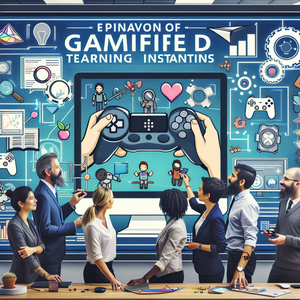The Rise of Gamified Learning: A Lucrative Niche in EdTech

Gamification refers to the incorporation of game-like elements—such as points, badges, leaderboards, and challenges—into non-gaming contexts. In education, this means transforming traditional learning experiences into interactive and enjoyable journeys. Research has shown that gamified learning can significantly increase student motivation, improve knowledge retention, and foster a sense of community among learners. A study conducted by the University of Colorado found that students who participated in gamified learning environments scored 14% higher on assessments than those who did not. This underscores the potential for gamification to not only engage students but also enhance their academic performance. By tapping into the innate desire for competition and achievement, gamified learning creates an environment where students are more likely to take an active role in their education.
Successful Startups Leading the Charge
The rise of gamified learning has led to the emergence of numerous successful EdTech startups. One notable example is Kahoot!, a game-based learning platform that allows educators to create interactive quizzes and challenges. Since its launch in 2013, Kahoot! has attracted millions of users worldwide, with teachers reporting increased student participation and enthusiasm. The platform's user-friendly interface and engaging format have made it a favorite among educators seeking to enhance classroom dynamics. Another standout in the gamified learning space is Classcraft, which transforms the classroom into a role-playing game. By allowing students to take on character roles and earn rewards for positive behavior and academic achievements, Classcraft has successfully transformed the classroom experience. With over $13 million raised in funding, this startup demonstrates the lucrative potential of gamified education, showcasing how innovative approaches can reshape the learning environment. Other notable mentions include Quizlet, which offers flashcards and games for studying, and Prodigy Math, an immersive platform that gamifies math learning for students in grades 1-8. These startups exemplify the growing trend of leveraging gaming mechanics to foster better educational outcomes.
Potential Earnings for Creators
The financial prospects for creators in the gamified learning niche are promising. As educational institutions increasingly recognize the importance of engaging learning experiences, the demand for gamified content has skyrocketed. Developers and educators with the skills to create compelling gamified materials can command impressive salaries and pursue freelance opportunities. According to a report from the Bureau of Labor Statistics, educational content developers in the United States can earn an average salary of around $63,000 per year. However, those specializing in gamification and interactive learning experiences may see even higher earnings, particularly if they can demonstrate measurable impacts on student engagement and learning outcomes. As the EdTech sector continues to grow, savvy entrepreneurs and creators are capitalizing on this demand, with some startups reporting multi-million dollar valuations.
Leveraging Gamification Techniques in Education
For educators looking to incorporate gamification into their teaching methods, several strategies can be employed. First, it is essential to clearly define learning objectives before implementing gamified elements. This ensures that the game mechanics align with educational goals and do not detract from the learning experience. Next, educators should consider using popular game formats, such as quizzes, simulations, and collaborative challenges. Platforms like Quizizz and Nearpod offer tools that make it easy to create immersive experiences that resonate with students. These tools encourage collaboration and competition, allowing students to learn from one another while having fun. Lastly, fostering a positive and inclusive classroom culture is crucial. Gamification can be a powerful tool for building community among students, but it is essential to ensure that all learners feel valued and included. Encouraging teamwork and recognizing individual achievements can help create a balanced and supportive environment. For example, incorporating team-based challenges can promote collaboration while allowing students to showcase their unique strengths.
The rise of gamified learning presents a wealth of opportunities for educators, developers, and entrepreneurs alike. As the demand for engaging and effective educational experiences continues to grow, those who can harness the power of gamification stand to benefit significantly. By exploring successful startups, understanding the financial potential, and implementing effective gamification techniques, we can pave the way for a more vibrant and impactful educational landscape. As we look to the future, gamified learning is poised to play a vital role in shaping the way we teach and learn, making education not only more effective but also more enjoyable for students of all ages. In conclusion, as the EdTech sector evolves, gamification offers an exciting frontier for educational innovation, presenting high-earning opportunities for creators and a means for educators to connect with students in meaningful ways. By leveraging gamification, we can inspire a generation of learners who are not only knowledgeable but also enthusiastic about their education.
Educational Game Designer
Kahoot!, Classcraft, Prodigy Math
Job Description
Develop engaging game mechanics and educational content tailored for specific learning outcomes.
Collaborate with educators to align gameplay with curriculum standards and enhance student engagement.
Proficiency in game design software (e.g., Unity, Unreal Engine) and understanding of educational psychology.
EdTech Product Manager
Quizlet, Nearpod, Duolingo
Job Description
Lead the development and enhancement of gamified learning products by defining product vision and strategy.
Conduct market research to identify user needs and trends in gamified education.
Strong background in project management and experience in Agile methodologies.
Instructional Designer with Gamification Expertise
Higher education institutions, corporate training departments, and EdTech startups
Job Description
Create interactive learning experiences using gamification techniques to boost learner engagement.
Utilize Learning Management Systems (LMS) and multimedia tools to design and implement educational courses.
Knowledge of adult learning principles and experience with tools like Articulate Storyline or Adobe Captivate.
User Experience (UX) Researcher in EdTech
Classcraft, Kahoot!
Job Description
Conduct user testing and gather feedback on gamified learning platforms to enhance usability and engagement.
Analyze user behavior data to inform design improvements and feature development.
Expertise in qualitative and quantitative research methods and familiarity with design thinking principles.
Data Analyst for Educational Outcomes
Schools, educational nonprofits, and EdTech companies focused on data-driven learning solutions
Job Description
Analyze student engagement and performance metrics to evaluate the effectiveness of gamified learning tools.
Provide actionable insights and recommendations to improve educational content and user experience.
Proficiency in data analysis software (e.g., SQL, Python) and strong statistical knowledge.


